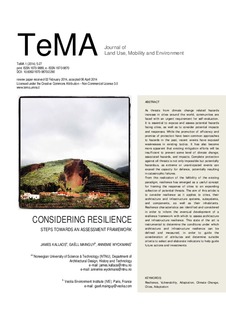| dc.contributor.author | Kallaos, James | |
| dc.contributor.author | Mainguy, Gaëll | |
| dc.contributor.author | Wyckmans, Annemie | |
| dc.date.accessioned | 2019-11-01T08:15:50Z | |
| dc.date.available | 2019-11-01T08:15:50Z | |
| dc.date.created | 2014-04-29T14:17:45Z | |
| dc.date.issued | 2014 | |
| dc.identifier.citation | Tema. Journal of Land Use, Mobility and Environment. 2014, 7 (1), 5-28. | nb_NO |
| dc.identifier.issn | 1970-9889 | |
| dc.identifier.uri | http://hdl.handle.net/11250/2626018 | |
| dc.description.abstract | As threats from climate change related hazards increase in cities around the world, communities are faced with an urgent requirement for self-evaluation. It is essential to expose and assess potential hazards facing cities, as well as to consider potential impacts and responses. While the promotion of efficiency and promise of protection have been common approaches to hazards in the past, recent events have exposed weaknesses in existing tactics. It has also become more apparent that existing mitigation efforts will be insufficient to prevent some level of climate change, associated hazards, and impacts. Complete protection against all threats is not only impossible but potentially hazardous, as extreme or unanticipated events can exceed the capacity for defence, potentially resulting in catastrophic failures.
From this realization of the fallibility of the existing paradigm, resilience has emerged as a useful concept for framing the response of cities to an expanding collection of potential threats. The aim of this article is to consider resilience as it applies to cities, their architecture and infrastructure systems, subsystems, and components, as well as their inhabitants. Resilience characteristics are identified and considered in order to inform the eventual development of a resilience framework with which to assess architecture and infrastructure resilience. This state of the art is instrumental to determine the conditions under which architecture and infrastructure resilience can be defined and measured, in order to guide the consideration of attributes and determine suitable criteria to select and elaborate indicators to help guide future actions and investments. | nb_NO |
| dc.language.iso | eng | nb_NO |
| dc.publisher | Cancelleria del Tribunale di Napoli | nb_NO |
| dc.rights | Navngivelse 4.0 Internasjonal | * |
| dc.rights.uri | http://creativecommons.org/licenses/by/4.0/deed.no | * |
| dc.title | Considering Resilience: Steps Towards an Assessment Framework | nb_NO |
| dc.type | Journal article | nb_NO |
| dc.type | Peer reviewed | nb_NO |
| dc.description.version | publishedVersion | nb_NO |
| dc.source.pagenumber | 5-28 | nb_NO |
| dc.source.volume | 7 | nb_NO |
| dc.source.journal | Tema. Journal of Land Use, Mobility and Environment | nb_NO |
| dc.source.issue | 1 | nb_NO |
| dc.identifier.doi | 10.6092/1970-9870/2290 | |
| dc.identifier.cristin | 1130520 | |
| dc.description.localcode | Open Access. This work is licensed under a Creative Commons Attribution 4.0 International License CC-BY. | nb_NO |
| cristin.unitcode | 194,61,55,0 | |
| cristin.unitname | Institutt for arkitektur og teknologi | |
| cristin.ispublished | true | |
| cristin.fulltext | original | |
| cristin.qualitycode | 1 | |

